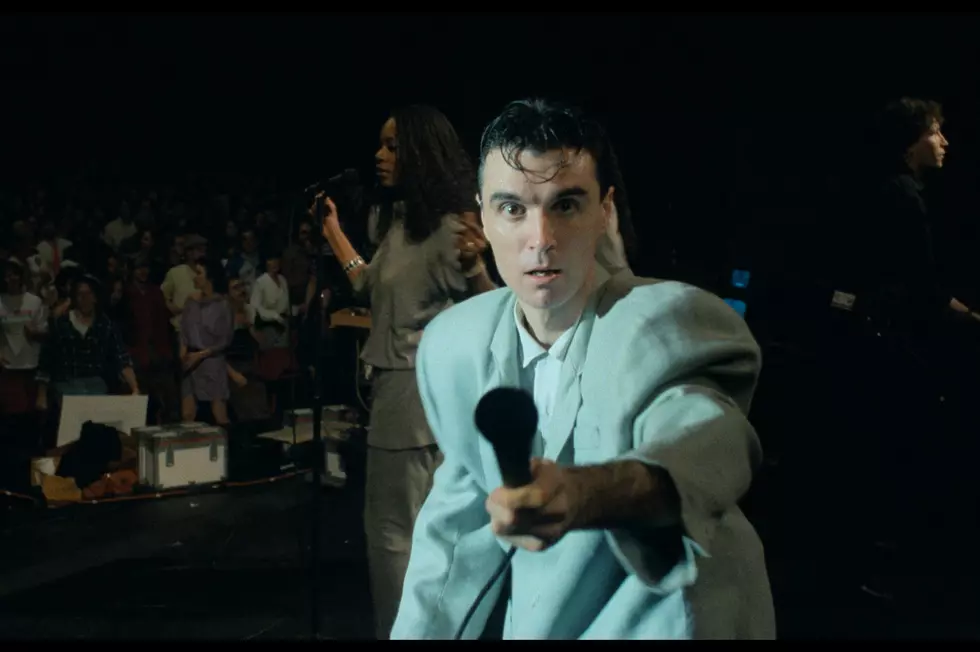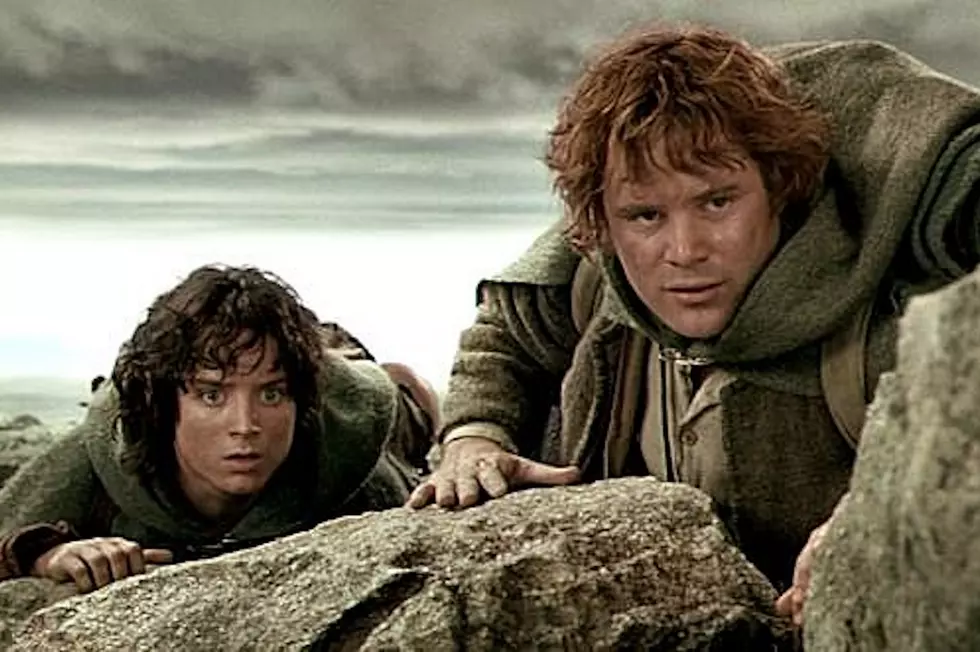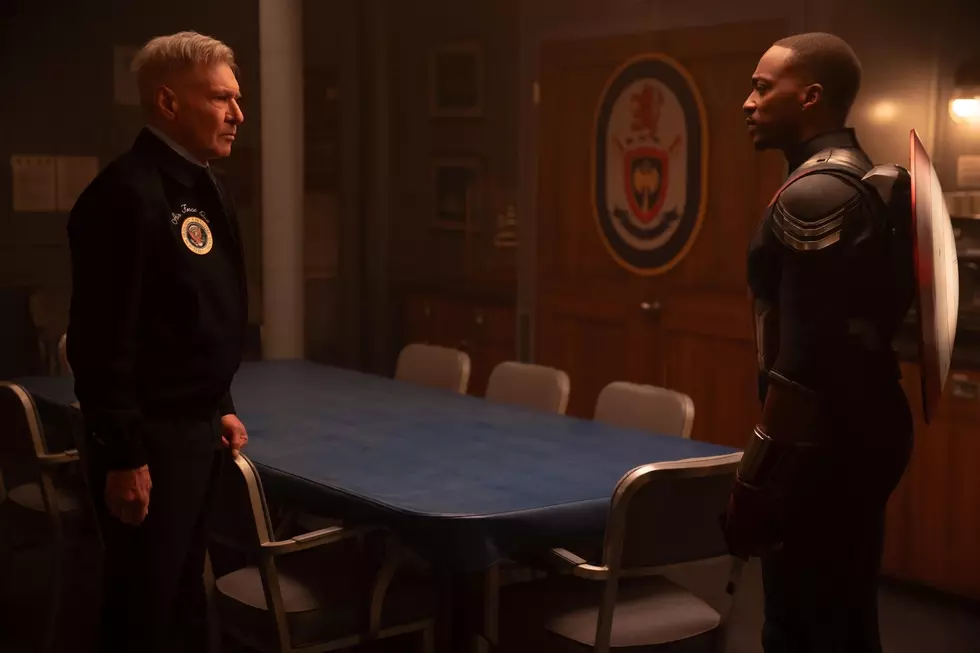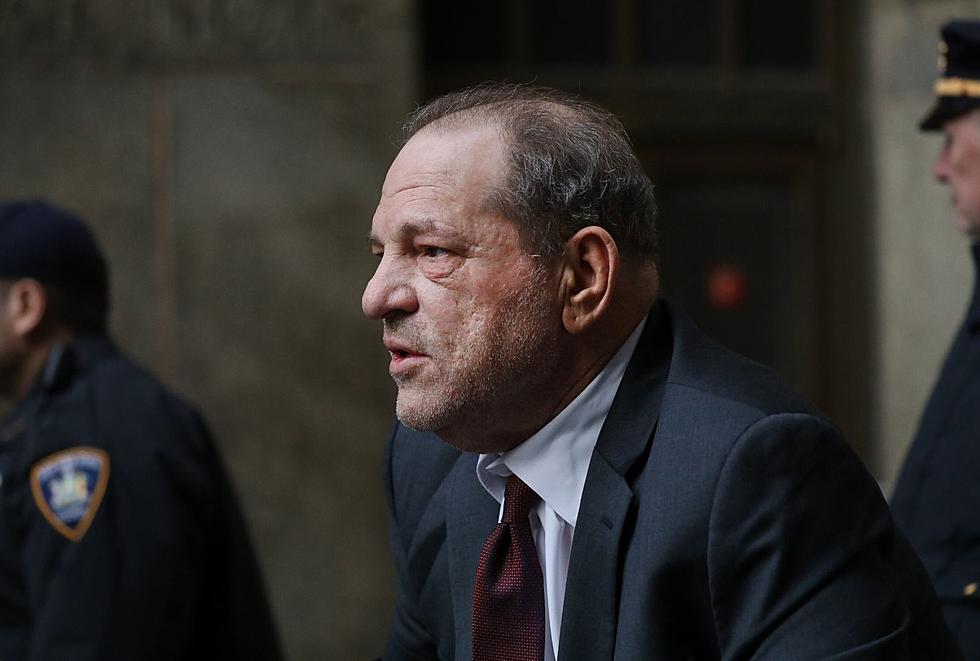
25 Classic Moments When Movies Broke the Fourth Wall
Early tracking estimates Deadpool could make upwards of $70 million this weekend; Forbes says it could be “the first R-rated comic book superhero blockbuster.” It’s already certified fresh on Rotten Tomatoes (though not by this critic). Excitement is high for Deadpool, and people are getting a huge kick out of the character’s snarky, self-mocking attitude. A big facet of Deadpool’s comic persona, one lifted directly from his comics, is that he is fully aware that he is a fictional character; even as he’s slicing and shooting bad guys he references the fact that he’s trapped inside a movie (and sometimes a pretty shoddy looking one) that’s part of a wider universe (he even refers to some of the famous actors who’ve played X-Men over the years).
Deadpool’s repeated breaks of the fourth wall make him special in the world of modern superheroes, but he’s hardly the first movie character to look into the camera and talk directly to the audience (or, for that matter, to refer to the fact that he’s a character in a movie). Inspired by Deadpool’s impending success, I’ve collected 25 of my favorite fourth-wall breaking moments, which you can watch below along with my thoughts on each.
Alfie (1966)
Directed by Lewis Gilbert
This famous British comedy features Michael Caine as a womanizing bachelor who discusses his sexual escapades with the audience. Talking to the camera insinuates the audience in Alfie’s activities; we almost become co-conspirators in his indiscretions.
Annie Hall (1977)
Directed by Woody Allen
It’s no coincidence that one of Annie Hall’s most famous moments — where Woody Allen’s Alvy Singer gets revenge on a pompous pseudo-intellectual media theorist by trotting out actual media theorist Marshall McLuhan to shoot him down — takes place in line at a movie theater. Even while Allen tells a very personal story of a love that came and went, he’s also exploring the machinery of storytelling. “Boy if life were only like this,” Woody chuckles as the punchline to the scene, underlining how the perfection we seek out in life can sometimes be found in the movies. In light of this theme, one of the most provocative aspects of Annie Hall is its ending. Even in the malleable world of the movies, Alvy can’t make his relationship with Annie end happily.
The Big Short (2015)
Directed by Adam McKay
To explain the unexplainable economic foundation beneath The Big Short, Adam McKay repeatedly breaks the fourth wall, trotting out celebrities to directly address the audience by breaking down these difficult concepts with easily intelligible metaphors. Here, in an abridged version of a very smart scene, chef Anthony Bourdain compares CDOs to seafood stew. In an essay in Film Comment, critic Eric Hynes noted how these scenes invert the structure of typical Hollywood biopics. “Facts aren’t employed to spin an entertaining narrative,” he writes, “but instead an entertaining narrative is employed to drive us to the facts.” Bourdain and his colleagues bring the facts, making The Big Short the rare R-rated Hollywood comedy that is actually educational.
Blazing Saddles (1974)
Directed by Mel Brooks
Fourth wall breaks have rarely been as literal as in the films of Mel Brooks. In High Anxiety, a camera plows through a glass door, disrupting a posh dinner party. In the third act of Blazing Saddles, the entire narrative collapses, revealing that its story of a Western town under assault is taking place on a Hollywood backlot next to productions like a ritzy black-tie musical. After some fancy steps, the roughnecks of Rock Ridge bust through the wall of the set. “Piss on you! I’m working for Mel Brooks!” hollers Slim Pickens as he punchs Dom DeLuise in the gut, sparking a massive fight between all the participants. Piss on you, reality. When we’re at a Mel Brooks movie, he’s the one in charge.
Crank (2006)
Directed by Neveldine/Taylor
In Neveldine/Taylor’s D.I.Y. D.O.A., Jason Statham’s assassin is poisoned with a lethal drug, and the only way to keep himself alive long enough to get revenge on his murderers is to constantly stimulate his heart with adrenaline. By the end of the film, the toxic chemicals, more mundane substance abuse, brutal fights, and public sex have taken their toll, and he’s beginning to lose his mind. In a subtle but very cool breaking of the fourth wall, a stranger’s subtitled dialogue appears reversed, floating in the air in front of Statham. He peers at it confusedly, and the superficial veneer of reality holding the film together crumbles even further.
Ferris Bueller’s Day Off (1986)
Directed by John Hughes
The most famous fourth-wall breaker in movie history might be slacker teen Ferris Bueller (Matthew Broderick), who brings the audience into his school-ditching schemes (and even into his shower, where he serenades us before covering the camera lens to clean his naughty bits). Ferris was also a post-credits scene pioneer; in the clip above he urges the remaining viewers to go home. Sharp-eyed Deadpool viewers will spot a reference to this sequence in the new film.
Fight Club (1999)
Directed by David Fincher
Edward Norton’s character narrates all of Fight Club, but his voiceover gets even more meta when he tells us about his buddy Tyler Durden (Brad Pitt). Turns out Pitt works as a projectionist, inserting naughty frames into whole children’s films (speaking of which, the clip above is, almost subliminally, NSFW). When Durden talks about cigarette burns — the small marks that used to denote reel changes back in the days when film was still projected on film — he points at one as it appears, on command, in the corner of the screen. Later, a Durden speech resonates so strongly that it shakes the celluloid in the projector, rendering the sprockets and soundtrack visible. Fight Club constantly references its movieness, a reminder that each person constructs (or, in this case, deconstructs) their own vision of reality.
Funny Games (1997/2007)
Directed by Michael Haneke
Be warned that the scene above counts as a major SPOILER, so if you haven’t seen either version of Michael Haneke’s Funny Games (which are very similar, although made ten years apart with different casts speaking in different languages) I probably wouldn’t watch it out of context. Anyone who has seen these brutal thrillers knows that they are two of the most fascinating moments of audience manipulation in movie history. Cinema is built on the idea that good can triumph over evil (at least in fiction). Funny Games offers a different view, one that ties God and director together, and suggests neither one is all that benevolent.
George of the Jungle (1997)
Directed by Sam Weisman
The old cartoons of Jay Ward Productions frequently employed wise-cracking, fourth-wall breaking narrators, and when these cartoons briefly became hot properties in Hollywood (until the live-action Adventures of Rocky and Bullwinkle flopped big time) they ported the same style of snarky, self-aware voiceover. Here, several characters actually get into a fight with the narrator, which is never a good idea, because he can talk about how you’re dumb and smelly and ugly and stuff.
Goodfellas (1990)
Directed by Martin Scorsese
Most of Ray Liotta’s narration in Goodfellas is given offscreen. At the very end of the movie, though, Liotta’s Henry Hill breaks from the movie’s illusion, gets up from his seat in a courtroom witness stand, and starts conversing directly with the camera. It lends extra oomph to that moment of finality when he says “And now it’s all over.” That’s followed by the shot where the camera tracks down Henry Hill’s new street in Witness Protection and comes to rest on his front door, where he picks up his newspaper and gives a sad smile. And then it’s all over.
Gremlins 2: The New Batch (1990)
Directed by Joe Dante
The Gremlins are such pure agents of chaos that they actually destroy their own movie in Gremlins 2: The New Batch. At one point, the film fries in the projector, and it turns out that the Gremlins have gotten into the projection booth and are wreaking havoc. It takes the intimidating might of a pre-racist sex tape Hulk Hogan to get them back in line. If more movies involved Gremlins, the world would be a much better place.
Horse Feathers (1932)
Directed by Norman Z. McLeod
Speaking of agents of chaos, the Marx brothers’ whole schtick involved demolishing the rules of “proper” storytelling, and they plowed through their movies with wild abandon. Modern audiences sometimes criticize their movies’ non-Marx brothers parts, mostly stiff love stories and sappy musical numbers. But those moments only put the Marxes’ comic digressions into sharper relief, as in this scene when Groucho speaks directly to the audience, telling them to make a break for the exits before things get too boring. You can draw a direct line from this sort of self-mockery to Deadpool’s riffs on his movie’s lack of bankable X-Men co-stars. (For another very similar joke, check out Bob Hope warning viewers a musical number is coming in 1952’s Road to Bali.)
JCVD (2008)
Directed by Mabrouk El Mechri
The autobiographical JCVD really breaks down the fourth wall. Jean-Claude Van Damme, playing himself, pauses the movie, a bank heist thriller, to deliver a lengthy monologue. As he speaks, Van Damme and the camera rise to the rafters so we can see the lights and equipment hanging above the set, further exposing filmmaking’s artificiality, and showing that we’re getting a glimpse behind the falseness of Hollywood and looking directly into his soul. The longer he goes, the more he breaks down. “I’ve done nothing!” he confesses as he looks back on his life and career. Ironically, JCVD’s best performance was his least athletic, when he simply was himself and spoke from his heart.
Kiss Kiss Bang Bang (2005)
Directed by Shane Black
How do you conclude a satirical send-up of noir tropes? By having your unlikely hero (Robert Downey Jr.) talk to the camera, and offer a message to take away from his Hollywood adventure — at least until his buddy (Val Kilmer) intrudes and cuts him off before he can tie a bow around everything for us. (Ironically, Downey’s Harry Lockhart is trying to tell us that the movie is really about friendship when Kilmer’s Perry interrupts and tells him to get his feet off his f---ing desk.) The fourth wall breaks go even further when Perry begs Harry to stop narrating and kindly requests the viewer stay for the closing credits. Otherwise, how will you know who made the kisses and the bangs?
Last Action Hero (1993)
Directed by John McTiernan
The breaking of the fourth wall in Last Action Hero (co-written by Kiss Kiss Bang Bang’s Shane Black) isn’t an isolated incident; the whole movie is built around a magical ticket that can send anyone back and forth through that wall between reality and movie. That’s what brings Danny (Austin O’Brien) into an adventure with his hero Jack Slater (Arnold Schwarzenegger), and that’s what brings Schwarzenegger back into the real world. Basically the whole movie could go on this list, but maybe the most purely pleasurable shattering of the fourth wall comes near the end of the film, after Slater returns to movie land armed with the knowledge about the movies he learned in Danny’s universe. He breaks his boss’ office door knowing it’ll shatter without leaving a mark on his hand and screams “I’m duh hero!” to his boss, confident in the knowledge that he can get away with anything. It’s all one big wink at the audience ... and then Schwarzenegger actually winks at the audience.
Monty Python’s The Meaning of Life (1983)
Directed by Terry Jones
Just take some drugs and watch this.
On Her Majesty’s Secret Service (1969)
Directed by Peter R. Hunt
When Sean Connery left the James Bond series after 1967’s You Only Live Twice, the filmmakers had to figure out how to explain his absence, and his replacement by George Lazenby. Rather than dwell on the change of star, they simply poked fun at it in the film’s cold open, and got on with the business of Bond. On the downside, Lazenby’s line of “This never happened to the other fellow,” has fueled a thousand tiresome fan theories about how James Bond is a code name passed down from one secret agent to another, and not just one guy who’s lived a bizarrely long life. (It was just a joke, guys. Get over it.)
Return of the Killer Tomatoes (1988)
Directed by John De Bello
Though not remembered as a comedic masterpiece, the moment the narrative of this Killer Tomatoes sequel breaks down, and the director admits they don’t have enough money to continue, and George Clooney comes to the rescue suggesting they use product placement, is not only funny, it anticipates decades of schlocky movies funded by thinly veiled commercials. Plus, who doesn’t love watching a young George Clooney hold up a Pepsi can very carefully so the camera catches the label?
Rubber (2010)
Directed Quentin Dupieux
The crazy tone is set early in Rubber, a movie about a killer tire, when a police officer exits his patrol car (holding a glass of water) and offers his thoughts on the history of film and the way that a philosophy of “no reason” links all the great masterpieces of world cinema. It doesn’t, but it certainly guides this one, and the way the cop (Stephen Spinella) talks about movies from a position of authority (while also being completely stupid) establishes Quentin Dupieux’s world of nonsensical madness.
Spaceballs (1987)
Directed by Mel Brooks
One more Mel Brooks classic for you, because how could I leave off the scene where Dark Helmet (Rick Moranis) figures out where Princess Vespa (Daphne Zuniga) is by watching the VHS of Spaceballs, the very film he is in and the very movie we are watching at that moment. Is it a screenwriting cheat? Yes, I suppose it is. But this scene blew my mind when I was 7 years old, and it gave us the immortal line “When will then be now?” (And the immortal response “Soon!”) for which we should all be eternally grateful.
Tampopo (1985)
Directed by Juzo Itami
Critic Jonathan Rosenbaum described Tampopo as a movie about “Food, Sex, and Death.” You can throw movies in there too, particularly in the opening scene where we meet a gangster (Kōji Yakusho) as he enters a movie theater, sits in the front (to an oddly formal meal) and then lectures the viewer on rude behavior, and mentions “the last movie” that all of us see flash before our eyes in the seconds before death. That, according to Rosenbaum, is “another form of savoring that, like eating and moviegoing, requires total concentration.”
24 Hour Party People (2002)
Directed by Michael Winterbottom
In 24 Hour Party People, Tony Wilson (Steve Coogan) serves as our guide through the Madchester music scene of the 1980s and ’90s. He often does so while commenting on the action; in the clip above he warns viewers to expect “a lot more of that sort of thing in the film” before noting that this hang-gliding mishap “did actually happen.” Wilson’s occasional asides are good for some laughs (and help indicate where the story is based on differing, or even conflicting, recollections of events), but they also help make the viewer feel like an insider, as if Wilson’s given each of us a personal invitation into this wild party.
Two-Lane Blacktop (1971)
Directed by Monte Hellman
I like how New York Times critic A.O. Scott puts it in his video essay about this great 1970s road movie: “It exposes not only the romance of the open road and the car culture, but also the emptiness, the nihilism.” That emptiness is neatly symbolized by the big fourth-wall break at the end of the film, when the print appears to catch fire and burn away in the projector. Universal’s print of the movie was missing this image for many years according to Kent Jones’ Criterion Collection essay. It’s a vastly different experience without it. It’s hard to depict a way of life burning out if you can’t show the flame.
Wayne’s World (1992)
Directed by Penelope Spheeris
Mike Myers is one of the great fourth-wall breakers of his generation, and he peppers one project after another with assorted nods and winks to the audience. Public access TV host Wayne Campbell (Mike Myers) frequently talks to the camera in both of the Wayne’s World movies, but maybe the boldest meta moment in either movie comes at the end of the first Wayne’s World, when Myers and company cycle through a series of possible endings, one sad, one Scooby-Doo inspired, and one “mega happy” where everything works out for the heroes. In discarding surprising conclusions for the most formulaic finale possible, Myers lays bare the Hollywood system that homogenizes idiosyncratic artists into identical products — the same way Wayne is terrified his beloved television show will be corrupted by big corporate sponsors if he sells out to a network.
The Wolf of Wall Street (2013)
Directed by Martin Scorsese
Jordan Belfort (Leonardo DiCaprio) is the ultimate salesman. When he tells you about his lifestyle, he’s really giving you a sales pitch; this guy’s so rich he can break his glass when he finishes his morning orange juice. Perhaps that’s why The Wolf of Wall Street became the subject of such debate about whether or not Martin Scorsese was endorsing or criticizing Belfort’s greedy ways. At times, it seems like he’s trying to hijack the movie from Scorsese, and to turn it into his own personal infomercial.
More From ScreenCrush

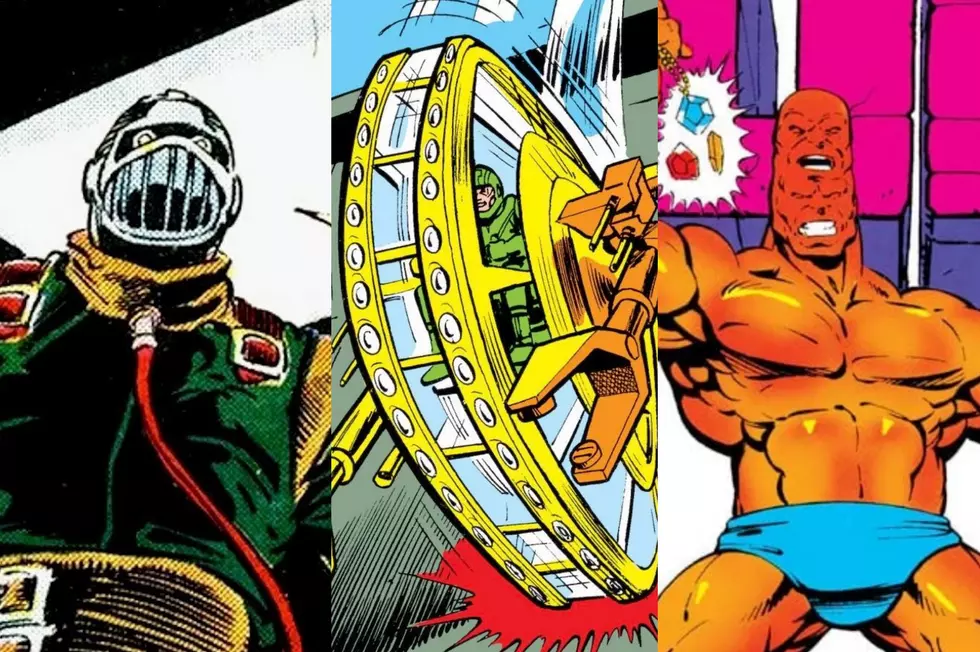


![Harrison Ford’s Spectacular $20 Million California Estate For Sale — See Inside! [Pictures]](http://townsquare.media/site/204/files/2024/04/attachment-harrison-ford-house-for-sale-pictures.jpg?w=980&q=75)
